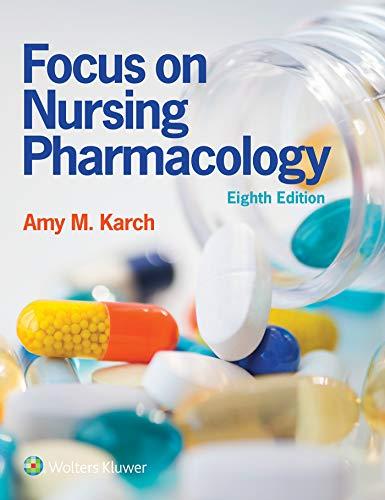What are the effects of this drug and what issues should be considered? Clinically significant drugdrug interactions
Question:
What are the effects of this drug and what issues should be considered?
Clinically significant drug–drug interactions occur with drugs that have small margins of safety. If there is very little difference between a therapeutic dose and a toxic dose of the drug, interference with the drug’s pharmacokinetics or pharmacodynamics can produce serious problems. For example, drug–drug interactions can occur in the following situations:
- At the site of absorption: One drug prevents or accelerates absorption of the other drug. For example, the antibiotic tetracycline is not absorbed from the GI tract if calcium or calcium products (milk) are present in the stomach. The calcium binds with the tetracycline.
- During distribution: One drug competes for the protein-binding site of another drug, so the second drug cannot be transported to the reactive tissue. For example, aspirin competes with the drug methotrexate (Rheumatrex) for protein-binding sites. Because aspirin is more competitive for the sites, the methotrexate is bumped off, resulting in increased release of methotrexate and increased toxicity to the tissues.
- During biotransformation: One drug stimulates or blocks the metabolism of the other drug. For example, warfarin (Coumadin), an oral anticoagulant, is biotransformed more quickly if it is taken at the same time as barbiturates, rifampin, or many other drugs. Because the warfarin is biotransformed to an inactive state more quickly, higher doses will be needed to achieve the desired effect. Patients who use St. John’s wort may experience altered effectiveness of several drugs that are affected by that herb’s effects on the liver. Digoxin, theophylline, oral contraceptives, anticancer drugs, drugs used to treat HIV, and antidepressants are all reported to have serious interactions with St. John’s wort.
- During excretion: One drug competes for excretion with the other drug, leading to accumulation and toxic effects of one of the drugs. For example, digoxin (Lanoxin) and quinidine are both excreted from the same sites in the kidney. If they are given together, the quinidine is more competitive for these sites and is excreted, resulting in increased serum levels of digoxin, which cannot be excreted.
- At the site of action: One drug may be an antagonist of the other drug or may cause effects that oppose those of the other drug, leading to no therapeutic effect. This is seen, for example, when an antihypertensive drug is taken with an antiallergy drug that also increases blood pressure. The effects on blood pressure are negated, and there is a loss of the antihypertensive effectiveness of the drug. If a patient is taking antidiabetic medication and also takes the herb ginseng, which lowers blood glucose levels, he or she may experience episodes of hypoglycemia and loss of blood glucose control.
Fantastic news! We've Found the answer you've been seeking!
Step by Step Answer:
Related Book For 

Question Posted:





